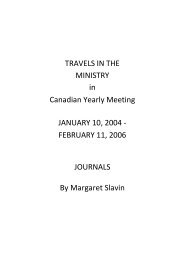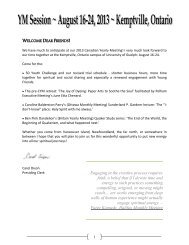Download pdf - Canadian Yearly Meeting
Download pdf - Canadian Yearly Meeting
Download pdf - Canadian Yearly Meeting
Create successful ePaper yourself
Turn your PDF publications into a flip-book with our unique Google optimized e-Paper software.
The Flowers and the Bees: Learning Through DiversityKeith R. Maddock“Like the bee gathering honey from the different flowers, the wise person accepts the essence ofthe different scriptures and sees only the good in all religions.”GandhiWilliam Penn wrote in 1693: “The humble, meek,merciful, just, pious, and devout souls are everywhereof one religion, and when death has taken off the maskthey will know one another, though the diverse liveriesthey wear here makes them strangers.”The value of this insight for contemporaryFriends, is that it may awaken our interest in religiousand spiritual diversity in an era when secular andmaterial values appear to be in ascendance. It mayalso remind us that the reality of such diversity in ourown communities provides openings for compassionand understanding. A look back into the history ofreligions is often helpful to appreciate the continuingimportance of spiritual and religious care, amidtumultuous changes in our world.St. Basil of Caesarea (CE 329-379), for example,learned about the Christian religion at home, underthe influence of his mother and grandmother. This wascustomary in the ancient world where the elementaryschool system taught literacy, mathematics, classicalGreek and Roman culture, but made no provision forspecific religious instruction. While Christian familiesdid not appear to question the value of a publiceducation, many believed that spiritual values wouldenable children to lead meaningful lives withoutbecoming absorbed into the mainstream culture.After pursuing a higher education in Athens,Basil became inspired by the example of mystics whoretreated into the desert, adopting contemplativediscipline to avoid worldly corruption. But he neededto learn that the contemplative life he desired wasalso influenced by Platonism and involved progressivediscipline leading to the creation of an ideal society.With this understanding, Basil learned to balancethe virtues of self-discipline and self-sufficiency withcompassion and social service.In a letter to his nephews he employed themetaphor of bees flying from flower to flower gainingsustenance from a variety of nectars before returningto their hive. This image has become a model for livingfaithfully and imaginatively in a pluralistic society.Truth can be experienced, to some degree, in the manyvarieties of religious and secular knowledge that are6available. Mahatma Gandhi may have had Basil inmind when he wrote: “Like the bee gathering honeyfrom the different flowers, the wise person accepts theessence of the different scriptures and sees only thegood in all religions”.Basil realized that the world he knew was richin diversity. Religious and cultural influences spreadthroughout the Roman Empire, Central Asia and theFar East. Universal toleration and openness to freshideas enhanced the whole life of his community.After Constantine adopted Christianity as the officialreligion of the Empire, monastic communities –founded by Basil, and others like him – continued topromote intellectual freedom through dialogue withother religions.The rise of Islam in the seventh century CE wasone of the most notable challenges to the hegemonyof official Christianity. Mohammed, who received hisrevelation in 610 CE, did not intend to found a newreligion, but to revive the faith that was taught by theancient prophets: Abraham, David, Moses, and Jesus.His role as “the last of the Prophets” was intendedto reaffirm this tradition as well as to protect it fromforeign (including Platonic and Gnostic) ideas thathad corrupted the original meaning.When the Islamic empire was less than five hundredyears old, the Sufis were attempting to reconcile Greekphilosophical ideas with the Koran and the teaching ofthe Prophet. One of the most respected teachers in thisenterprise was El Ghazali of Persia (CE 1058-1111), ascholar in many ways similar to Basil in method anderudition. He maintained that Sufism was the innerteaching of all religions, and used many quotes fromthe Bible and the Apocrypha to make his point. Oftenaccused of promoting religious syncretism, or tryingto cover all bases at once, he described his ideal of the“perfected man” as a person of integrity, whose universalinterest in humanity was more than superficial.The first principle of El Ghazali’s belief systemasserted that a student should be free to explore thewhole field of contemporary knowledge. The secondwas that a teacher should convey to his students thatwhich is within range of their personal experience.May 2013 - The <strong>Canadian</strong> Friend








